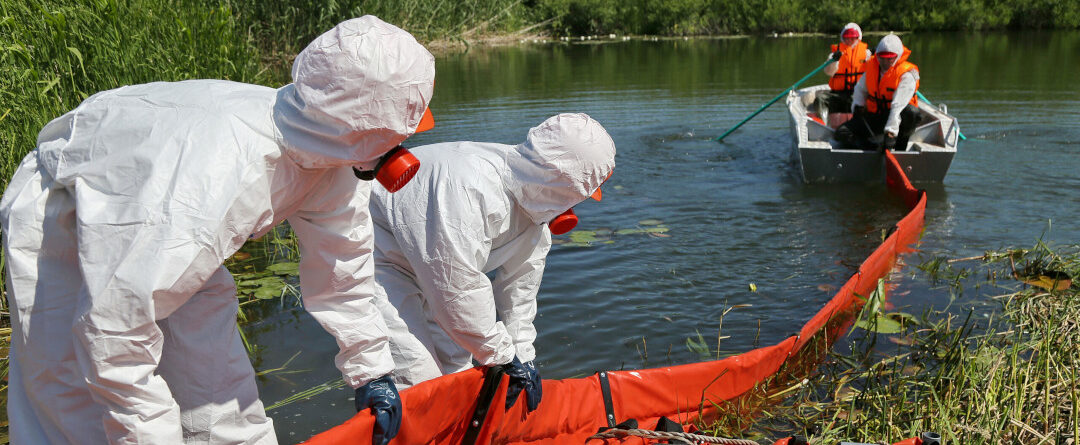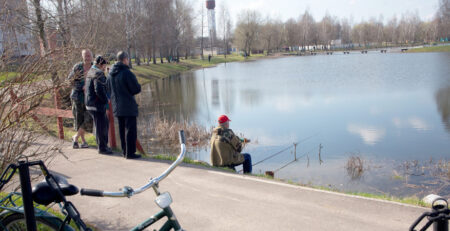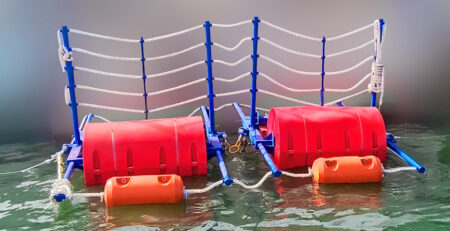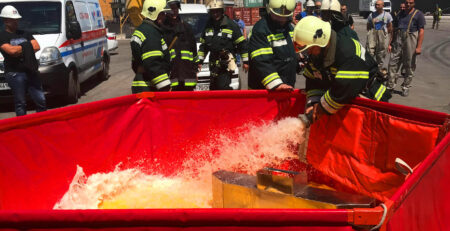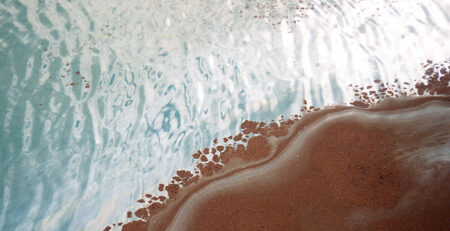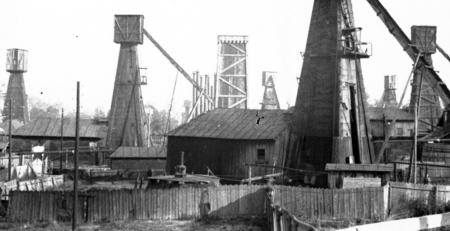Application of sorbing booms for elimination and prevention of oil pollution
Soloviev V.I.
Gubanov V.V.
Kozhanova G.A., Gudzenko T.V.
Syomina N.V.
Strengthening of anthropogenic loads on coastal sea areas is usually accompanied by an increase in the level of oil pollution. This is fully characteristic of the north-western Black Sea coast, where Ukrainian seaports and large transshipment complexes are concentrated. Therefore, for this region it is especially urgent to develop technologies and technical means ensuring effective oil spill response and protection of the sea coast from oil pollution.
To prevent oil pollution of the marine environment by oil products in the port water areas and to eliminate emergency oil spills, bonovye barriers of various designs are used as priority measures.
At present, for these purposes in the world practice, fast deployment booms “Hythe Sprint”, booms with bulkheads “Bulkhead”, security booms “Sentinel”, shore protection booms “Shargadian”, control barrier booms “Worden Fence Booms”, inflatable booms “Minipack/Maxipack” are widely used.
Ecoshelf booms are used for oil spill response in Russia. Various types of booms are also available in Ukrainian ports.
Bonanization of polluted sea areas with subsequent collection of oil products by oil waste collectors allows to collect up to 80 – 90% of spilled oil products with their reuse, but does not solve the problem of pollution elimination in full.
An additional effect can be achieved through the use of sorbing booms, which can not only localize oil slicks, but also sorb oil products. This type of booms in combination with conventional booms or as independent technical means are widely used. In particular, they are included in the OSR plan of Yuzhny Commercial Seaport (1).
This type of booms has a number of constructive differences, providing the possibility of oil products penetration inside the boom and their sorption. Sorbing booms are assembled from separate sections of different length (boom with USVR-1 m, boom “Multi-S” – 5 – 10m), which are made of mesh sleeve or permeable materials filled with synthetic or natural sorbents. As a rule, the diameter of boom sections varies from 100 to 200 mm. The main requirements to sorbents for filling booms are: absence of toxicity for humans and hydrobionts, hydrophobicity, buoyancy, high sorption capacity and easy disposal.
Some synthetic sorbents (“A-Sorb”, “Multi-S”) used in sorbing booms are characterized by high oil capacity. At the same time, polypropylene does not sorb oil products at all, but only retains them as a result of adhesion. A common disadvantage of synthetic sorbents, and, consequently, of booms in which they are used, is the difficulty of utilization. As a rule, it is carried out by incineration in special installations. Among synthetic sorbents in Ukraine for sorbing booms is used “Pearl” – expanded perlite and polypropylene rope cuttings.
For filling the booms, from the point of view of ecological purity and cheapness of raw materials, the most acceptable are sorbents based on organic natural substances – peat, sawdust, agricultural waste (bran, straw, rice husks, etc.). Among industrially produced abroad sorbents based on peat and moss the optimal are “Pit-Sorb” (Canada), “Fin-Sorb” (Great Britain), “Elkosorb” (Finland), “Mukat-4”, “Lesorb” (Belarus), “Sorboyl” and “Guminol” (Russia).
In order to eliminate oil spills and prevent oil pollution of the coastal strip, the Econad Research and Production Enterprise developed and tested biosorption booms “Econad” (2).
Booms of the required length are assembled from separate sections. The “Econad” boom section is a net sleeve with a diameter of 80 – 140 mm made of a strong polyethylene mesh with a mesh of 8 mm, into which is inserted a sleeve made of a mesh with a mesh of 5 mm, filled with sorbing material of organic origin. Top sphagnum peat is used as a filler. It is also possible to add moss, chopped straw, sunflower husk, textile and rope waste.
The used sorbents can be treated with suspension of microorganisms-destructors of oil hydrocarbons, which are used in the production of bacterial preparation “Econadine” (3,4,5). When eliminating pollution of water environment by light oil products (gas condensate, gasoline, kerosene, diesel fuel) “Econad” booms can be used repeatedly. The storage life of the booms is not less than 5 years. Disposal of used “Econad” booms is carried out by taking them to a landfill, plowing them on the badlands or burning them. Ekonad biosorption booms have been tested in the water area of the Yuzhny commercial seaport and during the elimination of oil film in sludge pits at the Kaverdinskoye field. In 2002 the booms were demonstrated at the 5th National Exhibition-Fair with international participation “Ecology 2002” and during the joint bilateral international command-staff exercises of the Ukrainian-Polish working group on elimination of emergency pollution of border waters “Mostiska – Starzhava 2002”.
Application of biosorption booms “Econad” allows blocking oil spills, providing sorption of a wide range of oil products. In addition, such booms can be used as preventive measures to protect shallow waters and shorelines and, first of all, recreational areas from oil pollution.
List of references
- План ликвидации разливов нефти в морском торговом порту Южный. – Одесса.- 2000.
- Кожанова Г.А., Соловйов В.І. Секція сорбуючого бону. Заявка на винахід (корисну модель) — №2002086620 від 9 серпня 2002 р.
- Кожанова Г.А. — Способ получения бактериального препарата для очистки водной среды от загрязнения нефтепродуктами. Патент №2033975, Россия// Б.И. – 1995.
- Кожанова Г.А..- «Спосіб одержання бактеріального препарату для сорбції та деструкції органічних речовин». Патент України на винахід №43394. 17.12.2001. Бюл. №11.
- «Еконадін» Технічні умови. (ТУ В 30171732-001-2000. Препарат бактеріальний “Еконадін”, реєстрація в Держстандарті 11.09.2000, № 095/004466). –11 с.

